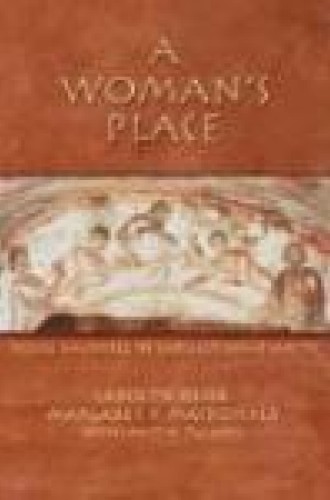A Woman’s Place: House Churches in Earliest Christianity
This book takes us back to the house church meetings of early Christians, meetings that “must have been noisy and bustling,” with women nursing babies, children underfoot, even toys on the floor. Like other contemporary scholars, Margaret MacDonald, Carolyn Osiek and Janet Tulloch are seeing women in ancient texts where they had not been seen before.
The recovery of women’s lives and agency both within the biblical text and in historical communities has been a major project in academia. MacDonald, Osiek and Tulloch have been significant contributors to this body of work, and in A Woman’s Place they synthesize much of the scholarship of the past three decades about Christian origins, early Christian social settings, and especially the lives of women and families in the Roman world, particularly with regard to house church communities. They explore the place of Christian wives, the experiences and education of girls, the moral landscape of female slaves in the house church and the role of women as leaders and patrons of house churches. In this synthesis the authors also include the significant scholarship of the past three decades on the Roman household and other Roman social contexts. So, for example, the leadership of women in the house church is set within norms for women’s lives in the Roman world, thus revealing many of the structures that affected women’s lives, such as the patronage system and slavery.
Much of the book’s energy is in chapters in which the authors do more than synthesize. In chapters with titles like “Dutiful and Less Than Dutiful Wives” and “Growing Up in House Church Communities,” they break new ground. Careful use of evidence and the exercise of imagination are both essential to good scholarship. The authors accomplish both and invite readers to do the same: to look more closely and carefully at women’s lives rather than uncritically appropriating what have become interpretive conventions—“patriarchy versus the discipleship of equals, public versus private, and ascetic versus domestic lifestyle.” It is this carefulness that prevents us from distorting the lives of women in the early church and at the same time frees us to see them with new eyes.
For instance, in the chapter on female slaves the authors ask why early Christian writers don’t speak directly about the sexual exploitation of female slaves within the household—indeed, within the house church. Before I read this chapter, it had never occurred to me to wonder whether Perpetua and her slave Felicitas may have carried children by the same father.
The authors present evidence for three propositions: that “masculine plural titles” should not always cause us to presume “the presence of men to the exclusion of women”; that “the cultural values of honor and shame” do not function as a single system, but are “actualized with significant variations”; and that “women participated in all the activities of the house church in the first generations of the Christian era and that the house church was the center for worship, hospitality, patronage, education, communication, social services, evangelization, and mission.” It is this last proposition especially that must inform our reading of early Christian texts about the house church if we are to learn to see the agency of women there.
This book is a gift to the church because it gives us not only eyes to see but ears to hear. While listening to the next epistle reading in worship, readers may imagine a bustling house meeting with children running around, women nursing infants, fathers holding children. A recovery of the domestic dimensions of worship that takes for granted the active presence of children can helpfully inform current congregational conversations about the nature of worship and its intersection with a robust and diverse family life.
While listening to Paul, Ignatius of Antioch and other early Christians as they identify themselves as slaves of Christ, readers may find themselves keeping in mind that a male slave was not considered a man and that he could not “claim any of the status inherent in the cultural construction of masculinity.” The radicality of Christian identity embedded in an early believer’s self-identification as a “slave of Christ” shakes us from the slumber of the privilege that is embedded in much Christian identity today. This book gives flesh and blood to early Christian texts, helping us to see and hear the layers of texture and meaning.
It is surprising how often my seminary students believe that women leaders in the church are an innovation of the 20th century. This represents a failure of memory, imagination and communication within Christian communities. A Woman’s Place makes it unequivocally clear that women leading worship, teaching, and spreading the gospel is an ancient tradition. Women’s leadership in the church in the late 20th century has helped us to see women’s leadership in the earliest Christian communities; conversely, knowledge of the many forms of ministry organic to the lives of early Christian women may help us to see the possibilities for women’s leadership in the body of Christ today.





